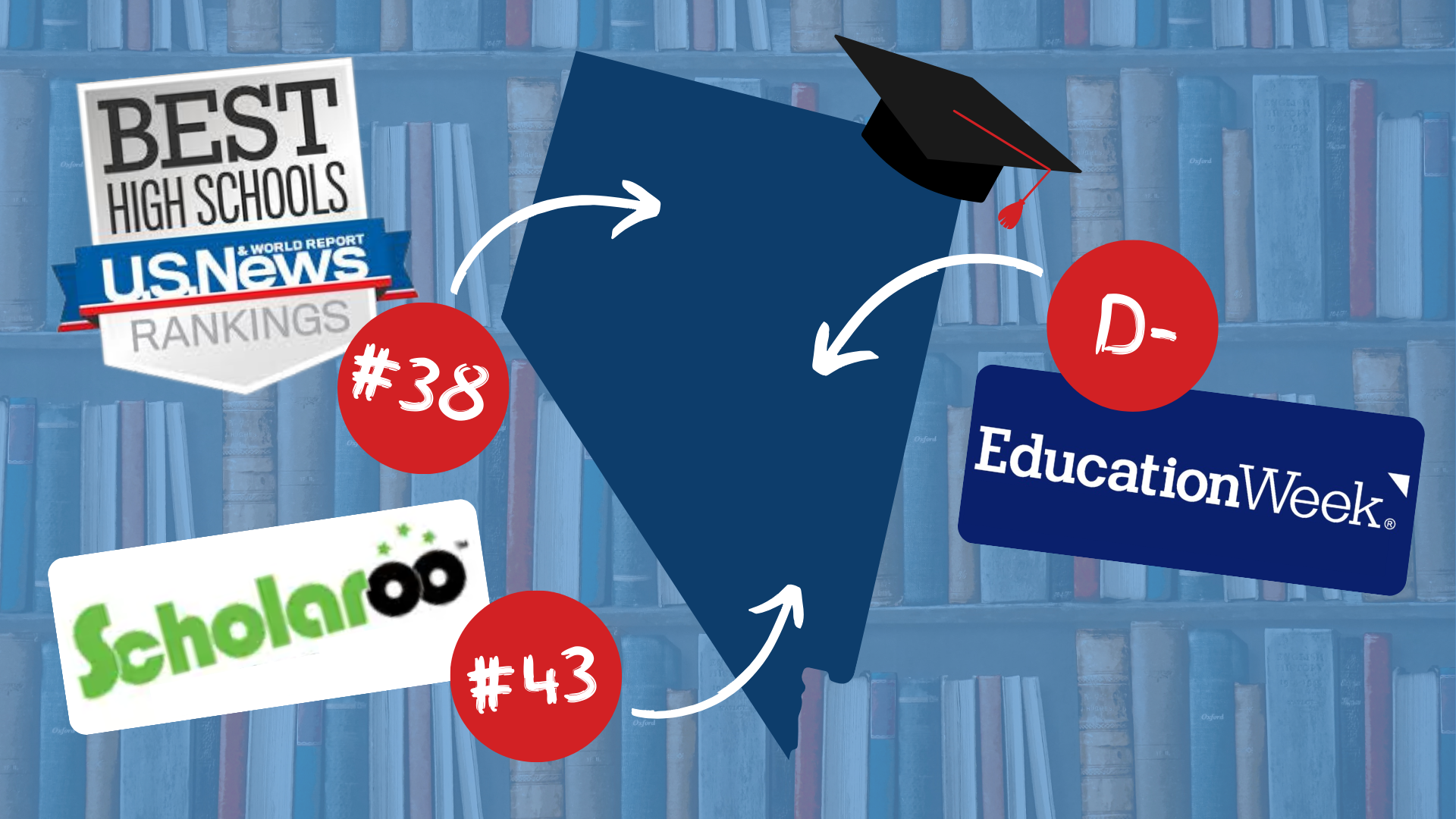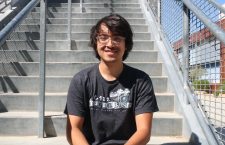NEVADA: TRULY THE WORST STATE FOR EDUCATION?

Clark, Washoe, Carson, Elko, Churchill and other counties make up the backbone of the Nevada education system. While rankings vary from study to study, Nevada consistently scores in the lower 10 states for education.
Most of the issues influencing these rankings are because of the amount of funding each state has for its education department. Ranking systems often give higher weight to education budgets, instead of teacher effectiveness or test scores, leading to the top spots being taken by states who spend the most money on education. Nevada being a lower spender on education, spending $5 thousand less per pupil than the national average, they are naturally ranked near the bottom. However, these rankings might not tell the whole story.
Magazines such as U.S. News and World Report and Scholaroo have included higher education rates and pre-K through 12 statistics into their methodology used to determine national education rankings. These factors have been deemed to not reflect the quality of education the state offers.
“When we see these reports about us being 49th in the nation, they are also including factors that are completely out of our control, right?” former Nevada Department of Education deputy superintendent Felicia Gonzales said. “Why are they counting master’s degrees in our community? Does that have anything to do with your success? No, right? Because you guys are amazing. My parents, they barely graduated high school. And in my education, I went all the way. So it didn’t have anything to their lack of access to school had nothing to do with my success.”
“If we took the metrics of how we educate the students in the state, through testing [or] graduation rates, we would actually be 18 out of 50 versus closer to the bottom,” 2024 Nevada State Teacher of the Year Laura Jeanne Penrod said. “But because no one has that conversation we only hear that we are the lowest in education and then we perpetuate that message in Nevada.”
Contrary to New Jersey, the highest state ranked in the Pre-K-12 section, Nevada does not offer free preschool to everyone. Only those who are income eligible below 200 percent of the poverty level can send their child to preschool for free through the Nevada Ready! Program. In 2024, the average preschool tuition in Nevada was $10,779.
“We have to look at education as from the moment babies are born all the way up until later on in life,” Penrod said. “How are we educating people? It’s not just when you enter school. So what opportunities are we providing at an early level? Unfortunately, Nevada doesn’t have an open Pre-K system. It’s usually a lottery or a paid system and so that right away affects our score.”
Best U.S. School District vs. CCSD by Shayna Migalang
Nevada’s heavy reliance on the leisure and hospitality industries, which employ over 22 percent of its population, contributes to the lower rates at which people pursue postsecondary education. A majority of jobs in this sector don’t require a degree. According to Higher Ed Info, only 58.16 percent of Nevadans choose to attend college after high school. This weighs down Nevada’s national ranking, although this is a factor that reflects Nevada’s nature as a tourism destination instead of the quality of its education.
“Let’s compare Las Vegas to Boston, Massachusetts. Boston [Massachusetts] has Harvard, right? They’re the center of their community. Can you imagine what their average degree looks like compared to Las Vegas?” Gonzales said. “There’s so many universities and colleges in that area that the average parent has a master’s degree. When parents come [to Vegas], what do you imagine their average degree is? They might not even have one.”
These two factors that have been considered in the rankings have consequently lowered Nevada’s score. Testimony proves that these rankings have caused a stigma toward lower-ranking districts.
“Those rankings are something that follows us around all the time. And they’re kind of pervasive in the community…those rankings are very, very public. They’re mentioned quite frequently not only on broadcast television but also on blogs, on online journalism sites,” Clark County School District (CCSD)Trustee Linda Cavazos said. “When they mention these rankings, that’s what all seems to rise to the top, you know, they’ll start off a story about CCSD. And then they’ll put something like 49th in the nation, something kind of facetious or sarcastic…It does affect [schools] more because it makes us very, very conscious that our number one priority needs to be our student achievement.”
Notwithstanding the previously stated methodology to determine rankings, according to The Nation’s Report Card, Nevada does rank around the national average in standardized testing. Niche has stated that 39 percent of students in CCSD meet the standard or exceed the reading/language arts proficiency tests. There is also a 21 percent proficiency rate in math.
“If we took the metrics of how we educate the students in the state, through testing [or] graduation rates, we would actually be 18 out of 50 versus closer to the bottom,” 2024 Nevada State Teacher of the Year Laura Jeanne Penrod said. “But because no one really has that conversation we only hear that we are the lowest in education and then we perpetuate that message in Nevada.”
Education leaders emphasize the importance of looking over every factor used when calculating student achievement. Who conducts the ranking, individual states’ academic requirements, and student performance statistics are elements that officials want to look more closely into.
“The [Nevada] Board of Trustees is going through a facilitated process to hear from the community,” chief strategy officer of Nevada Workforce Connections and CCSD Board Trustee Irene Bustamante-Adams said. “To remedy this, we have to change the message to the business community, to your parents, to the students of the fact that we’re not at the bottom of the bottom. We’re not, and you have to sell it that way. You have to educate people that way.”
Being home to the second largest school district in the country, many have expressed the need for the use of education funds to be managed well and with transparency.
On June 1, 2023, Nevada Governor Joe Lombardo signed Senate Bill 503, allocating a historic 12 billion dollars to improve education within the state. The bill marks a 2.6 billion dollar increase in funding for “sufficient funding for K-12 public education for the 2023-2025 biennium.”
“I believe that recently, the state and the county have been trying to show more interest in their students and our wellbeing,” senior Alyssa Hong said. “New screens for all classrooms that were implemented last year. Within our own school, I see that money is going towards making our lives as students easier. Now we have more pavement to create better routes for students to reduce the traffic during passing periods and new safety pads in the gym to prevent injuries but I think there can be a lot of room for improvement.”
NEVADA 2024 BUDGET by Kailie Sicolo
Programs like DonorsChoose were developed to aid in the financial support of teachers and staff. The state allocated 10 million dollars for teachers to apply for through DonorsChoose, signed by Governor Lombardo and Senator Marilyn Dondero Loop.
“Nevada [gave their students] less than $9,000…and that really, really hit our score pretty heavily,” Penrod said. “Now we’ve gotten to be a little bit closer to national standards, which is closer to $14,000 per student now, because we changed the funding formula. Nevada has $14,000 per student [to] spend and Massachusetts spends like 22 or $23,000 per student, so we’re still about $10,000 [less than] some of those upper scores that schools have.”
The program’s main focus is to empower teachers by allowing them to have adequate funding for tools that they may need in the classroom to support students better than they could in the past.
“I do wish that our school had better funding as well and I know they do have funding as they recently implemented the smart screens,” senior Purnima Neopaune said. “I know the nursing program could use better funding…I wish that before going to the nursing homes for my clinicals, I could have seen [the] equipment so I had a better understanding of how to use it and how to supply the clients I was taking care of…I wish our money did go into the programs because our school is a CTE school so I am hopeful for the future.”
Even with money allocated towards supplementing K-12 education in education, it has become increasingly difficult to retain quality educators.
“Recently in this and last year, the state legislature and the governor gave $2 million more to the State for funding,”Gonzales said. “With that funding, school districts could increase the amount of teachers in the classroom or the amount of people that would support them; however, there’s a teacher shortage. Schools that want to hire another math teacher or another English teacher or another fourth-grade teacher can’t if they’re not available. Not just here in Nevada, we are short on educators [as a nation].”
In Nevada, taxpayers are one of the most significant sources that fund education. According to The Kenny Guinn Center, property tax accounted for roughly $677.8 million (19.2 percent) spent on total statewide school operations in 2018. In Eureka County School District and Storey County School District, property tax contributed to over 50 percent of their funding.
“We know that as a state our tax policy needs to be modernized,” Bustamante-Adams said. “For example, we used to use a telephone book extensively, but now we don’t. So now [we] have this digital economy, [we can]download things, be able to listen to Audible books, things of that nature, but we haven’t modernized our tax policy and so we don’t even tax those entities. If [we] don’t go and capture the new things that are now in our economy, [our] investment in education will suffer because we’re not collecting that revenue as we should… As a state we need to continue to do more updating, revising our policies so that we are putting in the right amount of money for educating each child.”
With taxpayer money being used for education, it is crucial for the state and school districts to be transparent with how they are planning to use the money allocated to them.
“If I am being completely honest, I have no idea where our money actually goes,” Hong said. “Although I am graduating, I still have family members involved in our state’s education system and as someone who cares about them, I would like to see exactly where that money goes and how the district plans to support their learning and growth. As a young adult, who is beginning to pay taxes as well, I think it would be a good idea for school districts across Nevada, or even the country, to release a brief plan of how they plan to use taxpayer dollars.”
As of 2023, Nevada’s graduation rate is at 84.11 percent, ranking Nevada 49 in the country, making it the state with the highest dropout rate.
“I think schools in Nevada have such a low graduation rate because they just have such huge class sizes,” senior Hermoigne Sarmiento said. “It’s too hard to accommodate everyone because people have to realize that high school isn’t everyone’s main priority. I think if schools just offered more job opportunities in school it could help students from having to choose between school and a job.”
One factor that has largely contributed to Nevada’s low graduation rate is high chronic absenteeism in Nevada.
“In order for a child to learn, they have to be in school,” Bustamante Adams said. “Yes, there’s outside activities and field trips that you could use, but we know that if you’re not in school, it’s really hard to learn what you’re supposed to be taught. And so that’s why kids attending is so important. And there are so many barriers, so many challenges for kids these days and we have to focus on making sure that we can help their family and with the situations that we’re first facing so that they are able to go to school.”
Initiatives like Every Day Matters! are aiming to help students by offering attendance “tips” and resources for students and parents. Assistance can also be requested from their office and directly from their website.
“One of our most influential partners is called Communities In Schools [of Nevada] and they say one of the biggest barriers to defeating the scourge of absenteeism, chronic absenteeism, and low graduation rates is poverty,” Cavazos said. “[In] this last year of 2023, Communities in Schools, the students that they worked with have a 95 percent graduation rate, as compared to the overall CCSD rate. They address all basic needs, like transportation, housing needs, support, and all the social barriers.”
To combat absenteeism, schools are now turning to methods of discipline, including potential expulsion and suspension. The Nevada Department of Education suggests implementing a designated team of employees whose main focus is to prevent pupils from becoming chronically absent.
Absenteeism Rates by Kylie Chelise Dacquel
“There’s a lot of kids working to provide for the family and I think we live in a world where 7 a.m. to 2 p.m. school is not necessarily in the best interest for a lot of kids,” Assistant Principal Eric Gant said. “There’s a lot of different programs that fit the needs of kids who are working or doing those kinds of things and sometimes those are a better option. Getting that word out there for better educational programs to fit students who have to take care of their siblings or that kind of thing. The law says they have to be in some kind of school until they are 18, so I think that students need to find the best education option that works for them and their family to help them get across that finish line because there still is value.”
Others within the school system push for alternatives to regular schooling like online school to bring up graduation rates.
“I think it’s all about the kids,” Gant said. ”Connecting if they need help or they’re struggling with school. They need to have an adult that can help put them on the right path. There’s no shame in leaving traditional schools for a better environment that helps you get your grades. There shouldn’t be shame or embarrassment. The diploma is a diploma, and it’s going to get you into CSN or UNLV or Harvard or wherever.”
Vacancies, substitutes, and dozens of lost instructional days— these are the symptoms of a national teacher shortage epidemic. As the fifth-largest public school district in the country, Clark County School District (CCSD) must provide resources for over 300,000 students. Expectedly, the district has faced unique challenges while rapidly upscaling public education.
In January 2021, CCSD released a commission report on Teacher Recruitment and Retention to tackle the dwindling supply of public educators. The landscape of the teaching profession is changing; administrative focus at the district level has shifted from providing quality instruction to meeting basic expectations with educational skeleton crews. As a result, class sizes have inflated and instruction is less personalized.
“When I think back on my first year teaching versus my last year of teaching when I was in the classroom, it’s very different,” Clark County Education Association (CCEA) President Marie Neisess said. “The workload issues, the class sizes have always been an issue. But when you add the shortage of educators and [how] class sizes have gotten even larger due to that, it’s extremely difficult for our educators to meet the needs of our most struggling students.”
Beyond swelling workloads, undesirable work contracts, and public scrutiny, a tertiary concern of both prospective and current educators is classroom safety. Nevada has seen a number of violent student-on-teacher attacks, including an attempted murder in 2022. These constant concerns for safety may deter qualified workers from filling CCSD’s teacher vacancies.
“This is a national-level issue. We’re in a crisis where students are not going into the field of education for a number of reasons,” Neisess said. “Clearly, students who are in college see what’s happening throughout different states; whether it’s educators fighting for their pay and benefits, or dealing with violence in the classroom.”
Infographic Teacher Vaccancies by Venice Jingco
A side effect of staff shortages is a lack of administrative support for public school students.
“It typically seems to be where our schools do not have the support systems in place. Whether or not they don’t have enough social workers, counselors, school psychologists, things like that to deal with our students who are in crisis,” Neisess said. “But it also stems out of COVID issues that we had where our students were in crisis, where they’re thrown into a situation just like our educators that I’ve never had to deal with before.”
Though the issue of high teacher turnover and low retention rates existed prior to the COVID-19 pandemic, national school lockdowns accentuated these problems. Long-term distance learning may have also contributed to increasing student behavioral issues that remain unaddressed.
“I think that the issues were clearly there prior to that. I think they just didn’t see it as prevalent as it is now,” Neisess said. “And especially when we first came out of the pandemic and [with] students having to readjust—our younger students, especially when they missed out on actual instruction. Having a kindergartener sit and try to learn from a computer wasn’t ideal, and so all of a sudden, a couple of years later, returning to a school environment where they haven’t had that experience also was challenging for our students, but it’s always been there.”
The start of the 23-24 academic year was marked by a 1.875 percent pay redistribution from expected contract salaries for CCSD teachers. Though this deficit would be re-added to teacher pension funds, many educators felt that it essentially amounted to a pay cut. CCEA organized teacher protests in late 2023 advocating for higher teacher wages, as many educators felt their services were being undervalued.
“Our priorities were based on increasing their pay as well as increasing the contribution to their health insurance so that it wouldn’t come out of our pockets. Because if it comes out of our pockets, it’s basically a pay cut,” Neisess said. “Going to Carson City fighting for the funding; the governor as well as legislators, they put so much money into public education, so then we had to fight for that money. Unfortunately, it took over a third of our entire year to get to where we had a contract. And we lost educators during that time as well because again, we have to stay competitive.”
Digital Tool 2 by Venice Jingco
Resulting from classroom conflicts and protests for fair wages, teachers feel they’re no longer respected as professionals, as they are removed from the conversation regarding their own classrooms.
“In my personal opinion, I think we need to respect our educators and treat them like the professionals they are,” CCSD Trustee Linda Cavazos said. “They are not included on a widespread basis on a lot of these decisions being made for you [students], like your curriculum or platforms you use. And a lot of times, it’s not the school board. We are policy people, and we write policies; but we also write policies with the information that is given to us.”
On Feb. 1, CCSD introduced two new pay scales corresponding to an educator’s years of experience. The new charts indicate a focus on recruiting new teachers over retaining current ones, as there are differences in the tens of thousands when comparing the salaries of veteran teachers to new hires.
“Most of the time, it’s going to be the working conditions, and that includes a lot of different things,” Cavazos said. “But until we place an emphasis on not just recruiting teachers with a better salary, and bringing them in and offering them, this carrot and that carrot — if we don’t pay attention to our veteran teachers, and the ones that are mentoring the younger teachers, we’re not going to be able to keep them.”













